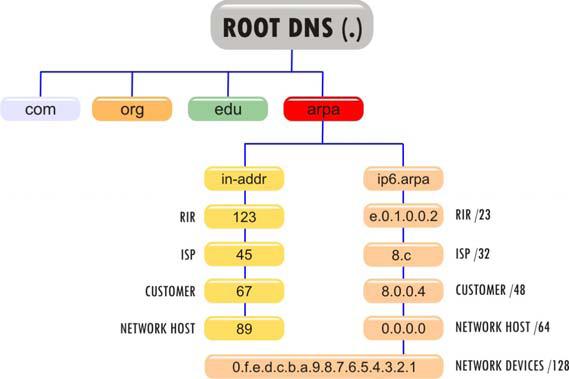The DNS root zone is the top-level DNS zone in the hierarchical namespace of the Domain Name System (DNS) of the Internet.
The National Telecommunications and Information Administration (NTIA), an agency of the United States Department of Commerce has exercised ultimate authority over the DNS root zone of the Internet since it was transitioned into private hands in 1997. In March 2014, the NTIA announced that it will cede this authority to an organization whose nature has yet to be specified. Through the NTIA, the root zone is managed by the Internet Corporation for Assigned Names and Numbers (ICANN), acting as the Internet Assigned Numbers Authority (IANA), while the root zone maintainer is Verisign. It is not known whether Verisign will continue in this role following the end of NTIA involvement.
A combination of limits in the DNS definition and in certain protocols, namely the practical size of unfragmented User Datagram Protocol (UDP) packets, resulted in a limited number of root name server addresses that can be accommodated in DNS name query responses. This limit has determined the number of name server installations as thirteen clusters, serving the needs of the entire Internet.
Initialization of DNS service
The DNS root zone is served by thirteen root server clusters which are authoritative for queries to the top-level domains of the Internet. Thus, every name resolution either starts with a query to a root server, or, uses information that was once obtained from a root server.
The root servers have the official names a.root-servers.net to m.root-servers.net. To resolve these names into addresses, a DNS resolver must first find an authoritative server for the net zone. To avoid this circular dependency, the address of at least one root server must be known for bootstrapping access to the DNS. For this purpose operating systems or DNS server or resolver software packages typically include a file with all addresses of the DNS root servers. Even if the IP addresses of some root servers change over the years, at least one is needed to retrieve the current list of all name servers. This address file is called named.cache in the BIND name server reference implementation. The current official version is distributed by ICANN's InterNIC.
With the address of a single functioning root server, all other DNS information may be discovered recursively, and information about any domain name may be found.
Redundancy and diversity
The root DNS servers are essential to the function of the Internet, as most Internet services, such as the World Wide Web and electronic-mail, are based on domain names. The DNS servers are potential points of failure for the entire Internet. For this reason, multiple root servers are distributed worldwide across the Internet. The number has been limited to thirteen addresses in DNS responses because DNS was limited to 512-byte packets until protocol extensions (EDNS) lifted this restriction. While it is possible to fit more entries into a packet of this size when using label compression, thirteen was chosen as a reliable limit. Since the introduction of IPv6, the successor Internet Protocol to IPv4, previous practices are being modified and extra space is filled with IPv6 name servers.
The root name servers are hosted in multiple secure sites with high-bandwidth access to accommodate the traffic load. At first, all of these installations were located in the United States; however, the distribution has shifted and this is no longer the case. Usually each DNS server installation at a given site is a cluster of computers with load-balancing routers. A comprehensive list of servers, their locations, and properties is available at root-servers.org. As of October 2014, there were 504 root servers worldwide.
The modern trend is to use anycast addressing and routing to provide resilience and load balancing across a wide geographic area. For example, the j.root-servers.net server, maintained by VeriSign, is represented by 74 (as of October 2014) individual server systems located around the world, which can be queried using anycast addressing.
Management
The content of the Internet root zone file is coordinated by the Internet Corporation for Assigned Names and Numbers (ICANN), which operates as the Internet Assigned Numbers Authority (IANA). Changes also must be authorized by the National Telecommunications and Information Administration (NTIA) of the U.S. Department of Commerce. VeriSign generates and distributes the zone file to the various root server operators.
Since 1997, when the Internet was transferred from U.S. government control to private hands, NTIA has exercised stewardship over the root zone. A 1998 Commerce Department document stated the agency was "committed to a transition that will allow the private sector to take leadership for DNS management" by the year 2000, however, no steps to make the transition happen were taken. In March 2014, NTIA announced it will transition its stewardship to a "global stakeholder community".
According to Assistant Secretary of Commerce for Communications and Information, Lawrence E. Strickling, March 2014 was the right time to start a transition of the role to the global Internet community. The move came after pressure in the fallout of revelations that the United States and its allies had engaged in surveillance. The chairman of the board of ICANN denied the two were connected, however, and said the transition process had been ongoing for a long time. ICANN president Fadi Chehadé called the move historic and said that ICANN will move toward multi-stakesholder control. Various prominent figures in Internet history, not affiliated with ICANN, also applauded the move.
ICANN's contract to perform the IANA function expires on September 30, 2015. Its role will not be affected immediately by the NTIA announcement.
Signing of the root zone
Since July 2010, the root zone has been signed with a DNSSEC signature, providing a single trust anchor for the Domain Name System that can in turn be used to provide a trust anchor for other public key infrastructure (PKI). The root zone is re-signed periodically with the root zone key signing key performed in a verifiable manner in front of witnesses in a key signing ceremony.

